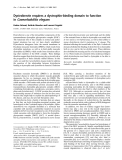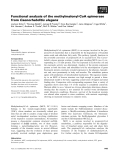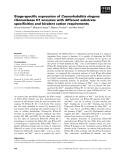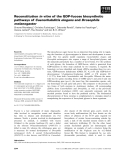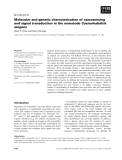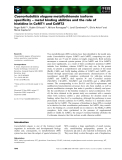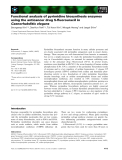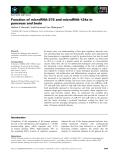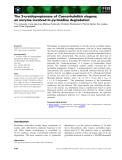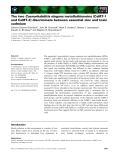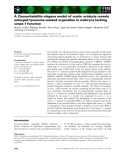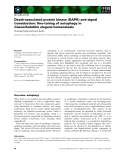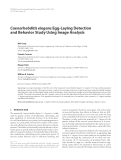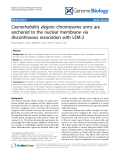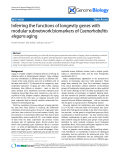
Caenorhabditis elegans
-
Dystrobrevin is one of the intracellular components of the transmembrane dystrophin–glycoprotein complex (DGC). The functional role of this complex in normal and pathological situations has not yet been clearly established. Dystrobrevin disappears from the muscle membrane in Duchenne muscular dystrophy (DMD), which results from dystrophin mutations, as well as in limb girdle muscular dystrophies (LGMD), which results from mutations affecting other members of the DGC complex.
 6p
6p  system191
system191
 01-06-2013
01-06-2013
 37
37
 5
5
 Download
Download
-
In the nematodeCaenorhabditis elegans, 40 genes code for astacin-likeproteins (nematodeastacins,NAS).The astacins are metalloproteases present in bacteria, invertebrates and vertebrates and serve avarietyof physiological functions like digestion, hatching, peptide processing, morphogenesis and pattern formation. With the exception of one distorted pseudogene, all the otherC. elegansastacins are expressed and are evidently functional. For 13 genes we found splicing patterns differing from the Genefinder predictions in WormBase, sometimes markedly....
 12p
12p  fptmusic
fptmusic
 12-04-2013
12-04-2013
 39
39
 3
3
 Download
Download
-
Báo cáo khoa học: Functional analysis of the methylmalonyl-CoA epimerase from Caenorhabditis elegans
Methylmalonyl-CoA epimerase (MCE) is an enzyme involved in the pro-pionyl-CoA metabolism that is responsible for the degradation of branched amino acids and odd-chain fatty acids. This pathway typically functions in the reversible conversion of propionyl-CoA to succinyl-CoA. The Caenor-habditis elegansgenome contains a single gene encoding MCE (mce-1) cor-responding to a 15 kDa protein.
 13p
13p  awards
awards
 06-04-2013
06-04-2013
 41
41
 3
3
 Download
Download
-
Ribonuclease H1 (RNase H1) is a widespread enzyme found in a range of organisms from viruses to humans. It is capable of degrading the RNA moiety of DNA–RNA hybrids and requires a bivalent ion for activity. In contrast with most eukaryotes, which have one gene encoding RNase H1, the activity of which depends on Mg 2+ ions, Caenorhabditis eleganshas four RNase H1-related genes, and one of them has an isoform produced by alter-native splicing.
 10p
10p  dell39
dell39
 27-03-2013
27-03-2013
 44
44
 3
3
 Download
Download
-
The deoxyhexose sugar fucose has an important fine-tuning role in regula-ting the functions of glycoconjugates in disease and development in mam-mals. The two genetic model organismsCaenorhabditis elegans and Drosophila melanogasteralso express a range of fucosylated glycans, and the nematode particularly has a number of novel forms.
 13p
13p  inspiron33
inspiron33
 26-03-2013
26-03-2013
 36
36
 3
3
 Download
Download
-
Four cDNA clones that were annotated in the database as encoding d-amino acid oxidase (DAAO) or d-aspartate oxidase (DASPO) were iso-lated by RT-PCR from Caenorhabditis elegans RNA. The proteins (Y69Ap, C47Ap, F18Ep, and F20Hp) encoded by the cloned cDNAs were expressed in Escherichia colias recombinant proteins with an N-terminal His-tag.
 13p
13p  inspiron33
inspiron33
 23-03-2013
23-03-2013
 39
39
 4
4
 Download
Download
-
Because arsenic is the most prevalent environmental toxin, it is imperative that we understand the mechanisms of metalloid detoxification. In prokary-otes, arsenic detoxification is accomplished by chromosomal and plasmid-borne operon-encoded efflux systems.
 7p
7p  galaxyss3
galaxyss3
 21-03-2013
21-03-2013
 43
43
 3
3
 Download
Download
-
The activation of ADAMTS (a disintegrin and metalloprotease with thrombospondin motifs) family proteases depends on removal of the prodomain. Although several studies suggest that ADAMTS activities play roles in development, homeostasis and disease, it remains unclear when and where the enzymes are activated in vivo.
 10p
10p  galaxyss3
galaxyss3
 07-03-2013
07-03-2013
 37
37
 5
5
 Download
Download
-
Osmotic homeostasis is a fundamental requirement for life. In general, the effector mechanisms that mediate cellular and extracellular osmoregulation in animals are reasonably well defined. However, at the molecular level, little is known about how animals detect osmotic and ionic perturbations and transduce them into regulatory responses.
 8p
8p  media19
media19
 04-03-2013
04-03-2013
 32
32
 2
2
 Download
Download
-
Two metallothionein (MT) isoforms have been identified in the model nem-atode Caenorhabditis elegans: CeMT1 and CeMT2, comprising two poly-peptides that are 75 and 63 residues in length, respectively. Both isoforms encompass a conserved cysteine pattern (19 in CeMT1 and 18 in CeMT2) and, most significantly
 17p
17p  vinaphone15
vinaphone15
 25-02-2013
25-02-2013
 45
45
 5
5
 Download
Download
-
To elucidate the function of kappa class glutathione transferases (GSTs) in multicellular organisms, their expression and silencing were investigated in Caenorhabditis elegans. In contrast with most vertebrates, which possess only one GST kappagene, two distinct genes encoding GSTK-1 and GSTK-2 are present in theC. elegansgenome.
 11p
11p  vinaphone15
vinaphone15
 25-02-2013
25-02-2013
 41
41
 3
3
 Download
Download
-
Pyrimidine biosynthesis enzymes function in many cellular processes and are closely associated with pyrimidine antagonists used in cancer chemo-therapy. These enzymes are well characterized from bacteria to mammals, but not in a simple metazoan. To study the pyrimidine biosynthesis path-way inCaenorhabditis elegans, we screened for mutants exhibiting resis-tance to the anticancer drug 5-fluorouracil (5-FU).
 12p
12p  vinaphone15
vinaphone15
 25-02-2013
25-02-2013
 53
53
 3
3
 Download
Download
-
In recent years, our understanding of how gene regulatory networks con-trol cell physiology has improved dramatically. Studies have demonstrated that transcription is regulated not only by protein factors, but also by small RNA molecules, microRNAs (miRNAs). The first miRNA was discovered in 1993 as a result of a genetic screen for mutations in Caenorhabditis elegans.
 13p
13p  viettel02
viettel02
 20-02-2013
20-02-2013
 39
39
 3
3
 Download
Download
-
Pyrimidines are important metabolites in all cells. Levels of cellular pyrimi-dines are controlled by multiple mechanisms, with one of these comprising the reductive degradation pathway. In the model invertebrateCaenorhabditis elegans, two of the three enzymes of reductive pyrimidine degradation have previously been characterized.
 10p
10p  viettel02
viettel02
 19-02-2013
19-02-2013
 33
33
 3
3
 Download
Download
-
The nematodeCaenorhabditis elegansexpresses two metallothioneins (MTs), CeMT-1 and CeMT-2, that are believed to be key players in the protection against metal toxicity. In this study, both isoforms were expressedin vitro in the presence of either Zn(II) or Cd(II).
 12p
12p  mobifone23
mobifone23
 21-01-2013
21-01-2013
 40
40
 3
3
 Download
Download
-
Gut granules are cell type-specific lysosome-related organelles found within the intestinal cells of Caenorhabditis elegans. To investigate the regulation of lysosome-related organelle size, we screened forC. elegansmutants with substantially enlarged gut granules, identifying alleles of the vacuolar-type H + -ATPase and uridine-5¢-monophosphate synthase (UMPS)-1.
 20p
20p  mobifone23
mobifone23
 18-01-2013
18-01-2013
 42
42
 3
3
 Download
Download
-
Autophagy is an evolutionarily conserved lysosomal pathway used to degrade and recycle long-lived proteins and cytoplasmic organelles. This homeostatic ability makes autophagy an important pro-survival mechanism in response to several stresses, such as nutrient starvation, hypoxia, dam-aged mitochondria, protein aggregation and pathogens.
 8p
8p  mobifone23
mobifone23
 18-01-2013
18-01-2013
 66
66
 4
4
 Download
Download
-
Tuyển tập báo cáo các nghiên cứu khoa học quốc tế ngành hóa học dành cho các bạn yêu hóa học tham khảo đề tài: Caenorhabditis elegans Egg-Laying Detection and Behavior Study Using Image Analysis
 12p
12p  dauphong20
dauphong20
 11-03-2012
11-03-2012
 39
39
 4
4
 Download
Download
-
Tuyển tập các báo cáo nghiên cứu về y học được đăng trên tạp chí y học Wertheim cung cấp cho các bạn kiến thức về ngành y đề tài: Caenorhabditis elegans chromosome arms are anchored to the nuclear membrane via discontinuous association with LEM-2...
 0p
0p  thulanh22
thulanh22
 20-11-2011
20-11-2011
 40
40
 3
3
 Download
Download
-
Tuyển tập các báo cáo nghiên cứu về y học được đăng trên tạp chí y học Wertheim cung cấp cho các bạn kiến thức về ngành y đề tài: Inferring the functions of longevity genes with modular subnetwork biomarkers of Caenorhabditis elegans aging...
 0p
0p  thulanh21
thulanh21
 15-11-2011
15-11-2011
 46
46
 2
2
 Download
Download
CHỦ ĐỀ BẠN MUỐN TÌM








